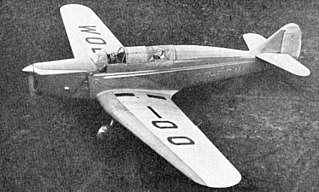
The RWD 4 was a Polish sports plane of 1930, constructed by the RWD team.

The RWD 17 was a Polish aerobatics-trainer aircraft of 1937, parasol wing monoplane, constructed by the RWD team.

The de Havilland DH.60 Moth is a 1920s British two-seat touring and training aircraft that was developed into a series of aircraft by the de Havilland Aircraft Company.

The Miles M.38 Messenger is a British four-seat liaison and private owner aircraft built by Miles Aircraft.

The General Aircraft GAL.42 Cygnet II was a 1930s British single-engined training or touring aircraft built by General Aircraft Limited at London Air Park, Hanworth.

The Auster J/5 Autocar was a late 1940s British single-engined four-seat high-wing touring monoplane built by Auster Aircraft Limited at Rearsby, Leicestershire.

The Arrow Active is a British aerobatic aircraft built in the 1930s.

The PZL-5 was a Polish two-seat touring and sports aircraft of 1930 constructed and produced by the PZL.

The Reid Rambler, later known under the Curtiss-Reid brand after Reid was purchased by Curtiss, was a biplane trainer/sport aircraft built in Canada in the early 1930s and used in small numbers as a trainer aircraft by the Royal Canadian Air Force.

The Miles M.65 Gemini was a British twin-engined four-seat touring aircraft designed and built by Miles Aircraft at Woodley Aerodrome. It was the last Miles aircraft to be produced in quantity.

The Fiat G.2 was an Italian three-engine six-passenger monoplane transport aircraft designed by Giuseppe Gabrielli and built by Fiat.

The SAI KZ II was a sport aircraft built in Denmark in 1937, produced in three major versions before and after the Second World War.

The de Havilland DH.81 Swallow Moth was aimed at the low-cost sporting aircraft market during the Great Depression. It was a single-engined two-seat low-wing monoplane; only one was built.

The Fairey Primer was a production version of the Avions Fairey Tipsy M tandem seat single-engined basic trainer. Two production aircraft were completed in the late 1940s.

The Miles M.15 was a 1930s British single-engined monoplane trainer aircraft with two open cockpits, designed and developed by Miles Aircraft. Like other aircraft constructed to the official specification, it failed to meet the performance requirements, and only two were built.

The Short S.7 Mussel was a single-engined two-seat monoplane built by Short Brothers to test the performance of their duralumin monocoque floats. Two were built.

The PWS-52 was a Polish sports aircraft of 1930, a single-engine high-wing monoplane, constructed by the Podlaska Wytwórnia Samolotów (PWS), that remained a prototype.

The Auster J series was a family of British light civil utility aircraft developed in the 1940s and 50s by Auster at Rearsby, Leicestershire.

The CASA III was a 1920s Spanish two-seat monoplane, designed by Luis Sousa Peco and built by Construcciones Aeronáuticas SA (CASA) at Getafe near Madrid.
The Emsco B-4 Cirrus was a mid-wing, two-seat trainer built in the US in the late 1920s. Six were built and three variants with more powerful engines flown.






















